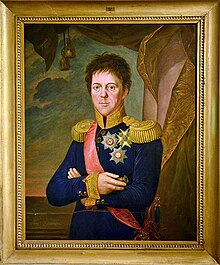Heinrich Friedrich Karl of Württemberg
Heinrich Friedrich Karl Duke of Württemberg (born July 3, 1772 in Mömpelgard , † July 28, 1838 in Ulm ) was a prince of the royal house of Württemberg . From 1802 he lived under the title and name of Graf von Sontheim .
Life
Heinrich Friedrich Karl was the youngest son of Duke Friedrich Eugen von Württemberg (* 1732, † 1797) from his marriage to Friederike Dorothea Sophia , born. Princess of Brandenburg-Schwedt and Princess in Prussia (* 1736, † 1798), daughter of Margrave Friedrich Wilhelm of Brandenburg-Schwedt . He was a brother of the first king of Württemberg, Frederick I , and the tsarina Maria Feodorowna .
Duke Heinrich grew up in Mömpelgard , his birthplace , where his father's family had lived since 1769. Although the father was Catholic, Duke Heinrich was brought up in accordance with the wishes of the state estates in Stuttgart in the Evangelical Lutheran faith of his mother. He also received military training. Because of the French Revolution in 1789, Duke Heinrich left the place of his childhood with his parents and siblings and lived alternately in Berlin, Vienna, Oels and Breslau.
Like his father, he entered the service of the Prussian Army . In 1794 he was already a major and, as such, was stationed in a cavalry regiment in Breslau in 1796. After his marriage in 1798, he resigned from Prussian military service with the rank of colonel. He now used the name Graf von Sontheim in public and lived in Berlin in 1802, and since 1803 in Treptow on Rega . From 1808 to 1822 Duke Heinrich was governor for Upper Swabia with the rank of lieutenant general of the cavalry. He took up his official seat in the Wiblingen Monastery , where a unit of the Württemberg Army that was subordinate to him was stationed.
From 1810 he lived in Ulm. He took part in Ulm hunting parties and song events and quickly became very popular in local civil society. In 1810 he was elected Grand Master of the Freemason Lodge Asträa to the three elms in Ulm, to which he had belonged since 1808. The Freemasons openly criticized the repressive absolutism in Württemberg at the time of Napoleon. The relationship with his brother, the King of Württemberg, was therefore increasingly strained because of disputes with the authorities, which escalated in 1813, and insults from 1808 until the king's death in 1816. Duke Heinrich had to stay away from the royal court in those years.
Duke Heinrich was a passionate hunter. He owned his own hunting ground near Ulm and collected antlers as well as hunting and forest calendars, as well as copperplate engravings with motifs related to hunting. His activity was also an occasion for him to deal with scientific questions about hunting and to publish numerous articles in various forestry magazines. A shotgun developed by him with improved rifle technology was presented in a magazine in 1824. Duke Heinrich owned an important collection of rifles that were auctioned off after his death.
From 1819 until his death, Duke Heinrich was a member of the First Chamber of the Württemberg estates as Prince of the House of Württemberg . He took part in the meetings until 1827, but after that he no longer appeared in the state parliament.
progeny
Duke Heinrich married the Breslau actress Christine Caroline Alexei (* 1779; † 1853) without permission in a morganatic marriage in 1798, who in 1807 received the title of Baroness von Rottenburg and in 1825 that of Countess von Urach for herself and her descendants. Because of the inappropriate marriage, Duke Heinrich renounced the succession to the throne in the Kingdom of Württemberg for himself and his descendants in 1807 . The marriage resulted in five daughters, but only two of them grew up:
- Marie (born December 15, 1802 in Berlin; † January 22, 1882 in Kirchberg), married Prince Karl Friedrich Ludwig zu Hohenlohe-Kirchberg (* 1780; † 1861) on May 26, 1821
- Alexandrine (* 18/19 December 1803 in Treptow an der Rega; † 21/22 August 1884 in Baden-Baden), married Count Karl Arpeau de Gallatin (* 1802; † 1877) in Ulm on July 3, 1830 , from whom she divorced in 1843 and then again carried the title of Countess of Urach.
Individual evidence
- ^ Christian Carl André, New National Calendar for the Entire Austrian Monarchy , Prague 1817, p. 1804
- ↑ a b c d Personal summary at Wiblingen Monastery
literature
- Gerald Maier: Heinrich Friedrich Karl . In: The House of Württemberg. A biographical lexicon , edited by Sönke Lorenz , Dieter Mertens and Volker Press , Verlag W. Kohlhammer , Stuttgart 1997, ISBN 3-17-013605-4 , p. 300 ff
- Frank Raberg : Biographical handbook of the Württemberg state parliament members 1815-1933 . On behalf of the Commission for Historical Regional Studies in Baden-Württemberg. Kohlhammer, Stuttgart 2001, ISBN 3-17-016604-2 , p. 1044 .
Web links
| personal data | |
|---|---|
| SURNAME | Württemberg, Heinrich Friedrich Karl von |
| ALTERNATIVE NAMES | Württemberg, Heinrich Friedrich Karl Duke of; Sontheim, Heinrich Friedrich Karl Count of |
| BRIEF DESCRIPTION | Prince of Württemberg |
| DATE OF BIRTH | July 3, 1772 |
| PLACE OF BIRTH | Montbeliard |
| DATE OF DEATH | July 28, 1838 |
| Place of death | Ulm |
